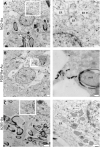Ultrastructural Characterization of Human Oligodendrocytes and Their Progenitor Cells by Pre-embedding Immunogold
- PMID: 34248510
- PMCID: PMC8262677
- DOI: 10.3389/fnana.2021.696376
Ultrastructural Characterization of Human Oligodendrocytes and Their Progenitor Cells by Pre-embedding Immunogold
Abstract
Oligodendrocytes are the myelinating cells of the central nervous system. They provide trophic, metabolic, and structural support to neurons. In several pathologies such as multiple sclerosis (MS), these cells are severely affected and fail to remyelinate, thereby leading to neuronal death. The gold standard for studying remyelination is the g-ratio, which is measured by means of transmission electron microscopy (TEM). Therefore, studying the fine structure of the oligodendrocyte population in the human brain at different stages through TEM is a key feature in this field of study. Here we study the ultrastructure of oligodendrocytes, its progenitors, and myelin in 10 samples of human white matter using nine different markers of the oligodendrocyte lineage (NG2, PDGFRα, A2B5, Sox10, Olig2, BCAS1, APC-(CC1), MAG, and MBP). Our findings show that human oligodendrocytes constitute a very heterogeneous population within the human white matter and that its stages of differentiation present characteristic features that can be used to identify them by TEM. This study sheds light on how these cells interact with other cells within the human brain and clarify their fine characteristics from other glial cell types.
Keywords: BCAS1; OPCs; human oligodendrocytes; immunogold; oligodendrocytes; transmission electron microscopy.
Copyright © 2021 Ulloa-Navas, Pérez-Borredá, Morales-Gallel, Saurí-Tamarit, García-Tárraga, Gutiérrrez-Martín, Herranz-Pérez and Garcia-Verdugo.
Conflict of interest statement
The authors declare that the research was conducted in the absence of any commercial or financial relationships that could be construed as a potential conflict of interest.
Figures








Similar articles
-
Evaluation of BCAS1-positive immature oligodendrocytes after cerebral ischemic stroke and SVD.Neurosci Lett. 2023 Aug 24;812:137405. doi: 10.1016/j.neulet.2023.137405. Epub 2023 Jul 20. Neurosci Lett. 2023. PMID: 37479175
-
Characterization of oligodendrocyte lineage precursor cells in the mouse cerebral cortex: a confocal microscopy approach to demyelinating diseases.Ital J Anat Embryol. 2010;115(1-2):95-102. Ital J Anat Embryol. 2010. PMID: 21072997
-
Age-Dependent Decline in Fate Switch from NG2 Cells to Astrocytes After Olig2 Deletion.J Neurosci. 2018 Feb 28;38(9):2359-2371. doi: 10.1523/JNEUROSCI.0712-17.2018. Epub 2018 Jan 30. J Neurosci. 2018. PMID: 29382710 Free PMC article.
-
The role of oligodendrocytes and oligodendrocyte progenitors in CNS remyelination.Adv Exp Med Biol. 1999;468:183-97. doi: 10.1007/978-1-4615-4685-6_15. Adv Exp Med Biol. 1999. PMID: 10635029 Review.
-
NG2-expressing cells as oligodendrocyte progenitors in the normal and demyelinated adult central nervous system.J Anat. 2005 Dec;207(6):707-16. doi: 10.1111/j.1469-7580.2005.00454.x. J Anat. 2005. PMID: 16367798 Free PMC article. Review.
Cited by
-
BCAS1 defines a heterogeneous cell population in diffuse gliomas.Oncotarget. 2024 Jan 24;15:49-64. doi: 10.18632/oncotarget.28553. Oncotarget. 2024. PMID: 38275289 Free PMC article.
-
Identifying Genes that Affect Differentiation of Human Neural Stem Cells and Myelination of Mature Oligodendrocytes.Cell Mol Neurobiol. 2023 Jul;43(5):2337-2358. doi: 10.1007/s10571-022-01313-5. Epub 2022 Dec 22. Cell Mol Neurobiol. 2023. PMID: 36547781 Free PMC article.
-
The organization of microtubules and Tau in oligodendrocytes: Tau pathology in damaged oligodendrocytes.Front Cell Dev Biol. 2022 Oct 5;10:950682. doi: 10.3389/fcell.2022.950682. eCollection 2022. Front Cell Dev Biol. 2022. PMID: 36274848 Free PMC article. Review.
-
Human cerebral organoids: cellular composition and subcellular morphological features.Front Cell Neurosci. 2024 Jun 12;18:1406839. doi: 10.3389/fncel.2024.1406839. eCollection 2024. Front Cell Neurosci. 2024. PMID: 38933177 Free PMC article.
-
Zebrafish optic nerve regeneration involves resident and retinal oligodendrocytes.Neural Regen Res. 2026 Feb 1;21(2):811-820. doi: 10.4103/NRR.NRR-D-24-00621. Epub 2024 Oct 22. Neural Regen Res. 2026. PMID: 39878527 Free PMC article.
References
LinkOut - more resources
Full Text Sources
Research Materials
Miscellaneous

